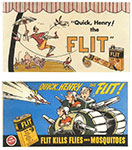|
QUICK,
HENRY—THE FLIT!
The Flitting
Life of Dr. Seuss
“Flit.” That
simple monosyllable earmarks one of the most celebrated advertising campaigns
of the 1930s. “Flit” was the brand name of an insecticide that had been
concocted in 1923. In those days before air-conditioning (which permits us to
keep all windows closed and bugs outside), every home faced summer with open
windows (for cooling breezes) and a bug-spray dispenser with a supply of spray.
Flit supplied both of the latter.
Flit
became famous in the next decade after Theodore Seuss Geisel had been
contracted to draw cartoons that illustrated with hysterical exaggeration some
insect-threatening situation in which the menaced person calls for rescue by
yelling: “Quick, Henry—the Flit!” 
In
the late 1920s, Geisel was drawing cartoons for the humor magazine, Judge, signing
his work “Dr. Seuss” (because, he explained, he was “saving the name Geisel for
the Great American Novel”). In the January 14, 1928 issue of the magazine, one
of his cartoons depicted a medieval knight, sprawled in bed, a snarling dragon
looming over him. Said the knight: “Darn it all—another dragon. And just after
I’d sprayed the whole castle with Flit!”

The
wife of the advertising executive handing the Flit account saw the cartoon in Judge at her hairdresser’s and urged her husband to contact the cartoonist and sign
him up. (Geisel said it was bald-faced luck: “It wasn’t even her regular
hairdresser. He was booked that day, so she went someplace else. Her regular
hairdresser was much ritzier and would never have had a copy of Judge in
his salon.”)
Geisel’s
contract lasted for the next seventeen years and presumably supplied him with
enough income (at one time, $12,000 a month) that he could spend a lot of his
time away from cartooning, devising, instead, the children’s books that made him
famous as a doctor without a degree. Not that he gave up cartooning. He
continued cartooning for Judge and expanded his client list to include
the old Life humor magazine and College Humor and Liberty magazine
until the early 1930s, when his contract with Flit prohibited such expeditions.
His
Flit drawings permitted him to exercise his most inventive cartooning
exaggerations. On one occasion, he showed a convict attacked by mosquitoes in
the middle of a prison break; in another, a seance is interrupted by a genie
emerging amid a swarm of bugs. In every case, the victims of the buggy attack
yell the four-word cry for help: “Quick, Henry—the Flit!”
Judith
and Neil Morgan in their Dr. Seuss & Mr. Geisel indicate the
pervasiveness of the Flit advertising campaign:
“The
phrase ‘Quick, Henry—the Flit!’ entered the American vernacular” and became a
punchline everywhere in the culture. “A song was written about it, and Geisel’s
cartoons spread from the pages of Judge and Life to newspapers,
subway cards and billboards. Comedians Fred Allen and Jack Benny used the tag line over the radio networks for dependable boffs, and across
America, the folksy mention of a bug spray evoked laughter. Flit sales
increased wildly. No advertising campaign remotely like it had succeeded before
on such a grand scale. The series found its way into histories of advertising
and was compared with the Burma Shave series of ubiquitous roadside rhymes. The
nearest thing to criticism was an agency warning that sometimes the bugs Geisel
drew were too lovable to kill.”
The
Flit campaign made Geisel an icon in the realm of advertising. “The campaign
was so successful,” said Phil Nel in his Dr.Seuss: American Icon, “that
Flit remains one of the primary ways in which Dr. Seuss is remembered. ... It
was the first major advertising campaign to be based on humorous cartoons.”
Despite
the nation-wide acceptance of his Flit cartoons, Geisel had no high opinion of
his work, according to Nel, confessing on more than one occasion that he could
not draw. “I still can’t draw,” he would say. “I always get the knees in wrong,
and the tails. I’m always putting in too many tails. I just can’t draw, I
guess. People like the Grinch. I started out to draw a kangaroo and it turns
out to be a Grinch. I don’t know, all my creatures seem to turn out catlike.”
Nel,
however, is quite aware of Geisel’s talent, particularly as manifest in the
books he wrote for children. “To appreciate Seuss’s artistic talents,” Nel
writes, “one must first examine the relationship between his art and the story.
It is the balance of words and pictures that makes the books work. As John Cech
observed after seeing the exhibition ‘Dr. Seuss from Then to Now,’ ‘when
pictures from Seuss’s books are displayed on museum walls [without the text],
one sees how utterly tied most of them are to the printed page and thus to
Seuss’s texts. For Seuss is a true artist of the picture book, a brilliant
master of that bimedial form, more than he is an artist whose visual works can
(or are designed to) stand alone.’ Though Seuss has created art that stands
alone ... the picture-book art is always interdependent with his text.”
Geisel,
in other words, is a cartoonist. Not a writer. Not an artist. But a
cartoonist, a storyteller who conjures up his visions in a perfect blend of
words and pictures. In each of his masterworks, Dr. Seuss achieved by creative
instinct a mutual dependency in which neither the words nor the pictures makes
as much sense alone without the other as they do together.
And
that talent is easily evident in his Flit ads—as you can readily tell from our
concluding array (which we begin with Seuss’s self-caricature wearing the
famous cat’s hat).
Return to Harv's Hindsights |